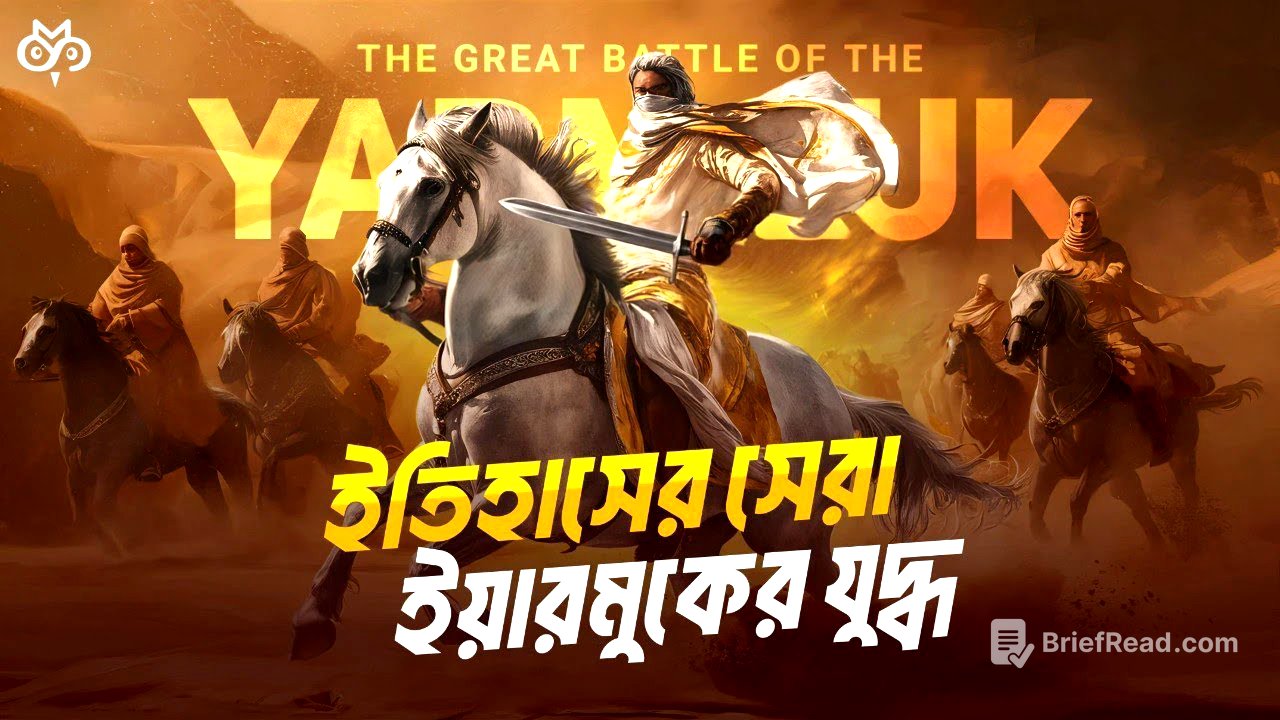TLDR;
The Battle of Yarmouk in 636 CE was a pivotal clash between the Rashidun Caliphate and the Byzantine Empire, resulting in a decisive Muslim victory that reshaped the geopolitical landscape. Led by the brilliant military strategist Khalid ibn al-Walid, the significantly smaller Muslim army triumphed over the heavily armed Byzantine forces, marking the beginning of Byzantine's decline in the Levant and the rise of the Muslims as a major power. The battle showcased Khalid's tactical genius, the unwavering determination of the Muslim soldiers, and the crucial role of strategic leadership in achieving victory against overwhelming odds.
- The battle took place on the banks of the Yarmuk River in 636 CE.
- Khalid ibn al-Walid led the Muslim army to victory against the Byzantine Empire.
- The victory marked the beginning of Byzantine's decline in the Levant and the rise of the Muslims as a major power.
Battle of The Yarmouk [0:00]
On August 15, 636 CE, the Battle of Yarmouk commenced near Damascus, Syria, pitting a smaller Muslim army against the formidable Byzantine Empire. The battle was poised to be a significant test for Khalid ibn al-Walid, a general renowned for his undefeated record, as he faced a superpower that had dominated the world for eight centuries. The atmosphere was tense as the two confident sides prepared for a battle that would alter the course of history.
Background Story - Yarmouk Battle [1:30]
At the time, the Arabian Peninsula was undergoing a transformation with the advent of Islam brought by Prophet Muhammad (PBUH). After his death, his companions took on the responsibility of spreading his message, facing resistance from the Roman and Persian empires. Despite being considered insignificant, the Arab nation was about to challenge these superpowers in a meaningful way.
Who's Khalid Bin Walid [2:10]
Khalid ibn al-Walid, born into a wealthy Meccan family, was a warrior from childhood, skilled in wrestling, swordsmanship, and horse riding. Shortly before the battle, Hazrat Abu Bakr (RA) passed away, and Hazrat Umar ibn al-Khattab (RA) became the new Caliph, who made the difficult decision to replace Khalid as general with Abu Ubaidah, fearing that soldiers were attributing victory to Khalid instead of Allah. Despite this change, Khalid accepted his new position and continued to contribute to the Muslim army's campaign.
Assembling the Armies [3:50]
By March 636, the Muslim army's actions had caused concern for Byzantine Emperor Heraclius, who assembled a massive force of around 200,000 soldiers from various regions. This army was divided into several commands, with General Vahan in overall command. Meanwhile, the Muslim army was scattered across different locations, which Heraclius aimed to exploit.
Byzantine Empire vs. Rashidun Caliphate [4:30]
Heraclius sought an alliance with the Persian Emperor Yazdegerd III by marrying his daughter to him, aiming to create a united front against the rising Muslim power. His strategy was to attack the Muslim forces on both the Syrian and Persian fronts simultaneously. However, Hazrat Umar ibn Al-Khattab proposed a ceasefire to Yazdegerd, delaying potential conflict with the Persians. Learning of Heraclius' plans through Roman prisoners, Khalid ibn Walid advocated for consolidating the Muslim forces into one location for a stronger, unified attack.
Military Strategy [7:00]
Khalid ibn Walid proposed gathering the scattered Muslim forces near the Yarmouk plains, close to the Golan Heights, to unite and fight as one. This strategic retreat aimed to regroup and launch a more powerful attack, preventing the Muslim army from being crushed by the isolated Byzantine forces. Despite Abu Ubaidah being in command, he entrusted full responsibility to Khalid ibn Walid at this critical stage.
Day 1 - Conquest of Levant [9:33]
General Vahan positioned his army strategically, but the location was troublesome due to the sun's glare and a deep gorge behind their camp. Khalid ibn Walid had already established his camp in a strategically advantageous position. Vahan attempted to negotiate with Khalid, but Khalid firmly stated their mission to invite them to Islam or face war. On the first day of battle, Vahan divided his army into four parts, and after initial challenges, a fierce battle began, with neither side suffering significant losses.
Day 2 - Military Strategy [10:58]
The Romans launched an early morning attack, but Khalid was prepared and had arranged the battlefield to prevent surprises. The weakest position was on the far right, where Amr's army stood, so the Qanatir forces attacked there with all their might. Khalid seized the perfect timing to cause significant damage to the Romans, forcing the Slavic troops to retreat. Despite challenges on the left flank, the Arab women's bravery and Khalid's reinforcements helped repel the Greek forces, resulting in the death of the Armenian commander Dairjan and enormous losses for the Romans.
Day 3 - Magnificent Muslim Heroics [13:05]
Vahan's army launched a coordinated attack, targeting the Muslim army's right flank, but Jabalah's army left themselves vulnerable, allowing Khalid ibn al-Walid's forces to surround and attack them. Khalid’s timing and tactics forced Jabalah and Qanatir’s armies to retreat, resulting in a victory for the Muslims on the third day.
Day 4 - The Day of the Lost Eyes [13:50]
Vahan's army charged at the right flank again, while the other two sides slowly advanced forward. Khalid ordered the two units on the left flank to advance, creating a gap, and seizing the opportunity, Khalid’s army launched an attack against Jabalah’s forces. Vahan ordered his archers to shoot arrows at point-blank range targeting Abu Ubaidah’s forces, and many Muslims were injured, including Abu Sufyan, whose one eye became blinded. The Arab soldiers retreated slightly to move out of the range of the archers. The Arab women took up arms, inspiring the men to fight again with renewed vigor.
Day 5 - Truce Proposal from the Romans [15:35]
Vahan surprised everyone by sending a ceasefire proposal to Khalid. The Arab leaders gathered for an urgent meeting, but Khalid rejected the proposal, stating that it was time to secure victory through their final attack. He knew that the Byzantines were mentally defeated and that Vahan was trying to delay. That night, Khalid met with all the soldiers, and despite their injuries, their resolve and determination showed no signs of wavering.
Day 6 - The Biggest Victory of the Muslims against Romans [17:18]
On the final day, Gregory advanced and was met with a duel challenge by Abu Ubaidah, who handed over all responsibilities to Khalid in case he didn’t return. Abu Ubaidah killed Gregory, and Khalid called for his Muslim lines to advance. He had reorganized his troops and hidden a cavalry unit in a part of the mountain. The Byzantines couldn’t believe their eyes, wondering how a wounded army dared to attack after such irreparable losses. The hidden cavalry emerged, and Khalid’s army infiltrated their unprotected right flank. Khalid swiftly crushed Kanatir and Jabal, then rushed towards the position of Vahan in the center.
After the Ultimate Victory of the Muslims [20:00]
The Romans began fleeing in confusion, and the hundreds of thousands of Byzantine soldiers lost all sense of direction. The commander Vahan was killed, and half of the massive Byzantine army’s forces were killed by the Muslims. The Muslims achieved victory in one of the greatest battles in history, making Khalid immortal. The Battle of Yarmouk was a game-changing event in world history, marking the beginning of the Byzantine’s downfall in Syria and the Levant. With this victory, the term ‘superpower’ was added to the Muslims.









